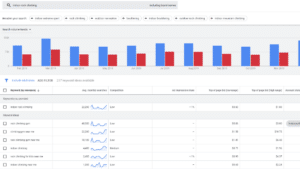Search engine optimization (SEO) is the process of implementing strategies that so a site’s webpages appear high on a list of results returned by a search engine such as Google or Bing.

Search engine optimization is a holistic strategy that should be integrated with every aspect of a website. Google has over 200 ranking factors in their algorithm. The exact weights of each of these factors are not known, because Google wants to make sure that their “secret sauce” is protected. What we do know is that almost every aspect of a website is considered when Google calculates whether to show a page in a search result. Since Google’s main goal is to provide its users with high-quality search results, most of the time optimizing a website for a search engine overlaps with improvements that will also optimize a website for a visitor. Essentially SEO is implementing best practices and continually improving your website with users and search engines in mind.
What is an Example of SEO?
We can categorize SEO into five main categories. These categories are technical SEO, on-page SEO, off-page SEO. Website functionality and social media marketing are important subcategories of on-page and off-page SEO respectively. When discussing the types of SEO we are only considering white hat strategies as black hat and gray hat strategies will inevitably be penalized and will ultimately result in decreased rankings.
Technical Search Engine Optimization
Technical SEO involves strategies that make it easier for search engines to crawl and index your site. Some examples of technical SEO are including an XML sitemap, making sure that you have an SSL certificate, making sure your site points to the https version and improving your website’s load speed. These are only a few examples. There are many optimizations that a website can undergo in order to improve its technical SEO.
On-Page Search Engine Optimization
On-page SEO is just like it sounds. It is all of the optimizations that are done on the webpage itself. This includes any SEO done that optimizes the content on the page or the HTML code. On-page optimizations make it easier for search engines and users to identify the purpose of a page. This includes adding relevant keywords to the titles, descriptions, and body of the page. It also includes quality optimizations such as making sure that the content on the page is of sufficient length and is not a copy of another webpage. A lot of the time, on-page SEO is what many people think of when they think of SEO. This is because on-page SEO is highly linked to the success of keyword research and keyword implementation
Off-Page Search Engine Optimization
Off-page SEO is also just like it sounds. Off-page optimizations are strategies that are done outside of your website. A large part of off-page SEO is gaining links to your website from third parties. These links to your website are referred to as backlinks. Some common methods of building backlinks are listing your website in business directories, getting influencers to share your page or including a link in a press release. Social media does fall under the category of off-page SEO since it is technically done outside of your website.
What Does Seo Have to Do with Marketing?
Search engines like Google take a comprehensive look at which web page they want to display for a keyword and have a wide selection of ranking factors that they use in their algorithms. Content marketing, social media marketing and online advertising are all considered as a part of those algorithms. Marketing by definition is the act of promoting your products and services. It only makes sense in today’s age that digital marketing is an essential component of any business’s marketing mix. Search engines play such an important role in directing traffic to websites that SEO and digital marketing have become expressly linked.







